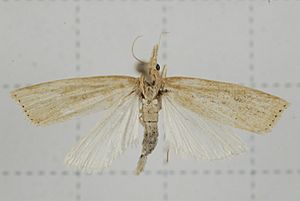Asiatic rice borer facts for kids
Quick facts for kids Asiatic rice borer |
|
|---|---|
 |
|
 |
|
| Scientific classification | |
| Kingdom: | |
| Phylum: | |
| Class: | |
| Order: | |
| Family: | |
| Genus: |
Chilo
|
| Species: |
C. suppressalis
|
| Binomial name | |
| Chilo suppressalis (Walker, 1863)
|
|
| Synonyms | |
|
|
The Asiatic rice borer, also known as the striped rice stemborer, is a type of moth from the family Crambidae. Its scientific name is Chilo suppressalis. This moth is found in many places, including Iran, India, Sri Lanka, China, Japan, Taiwan, Malaysia, and even islands in the Pacific Ocean.
This moth is a serious problem for rice farms. It causes a lot of damage to rice crops, especially in East Asia, India, and Indonesia. It is believed that humans accidentally brought this moth to Spain and Hawaii. From there, it has spread to places like the Northern Territory of Australia.
Contents
What Does the Asiatic Rice Borer Look Like?
The Asiatic rice borer is a small moth. The male moths have a wingspan of about 18 millimeters (about 0.7 inches). Female moths are slightly larger, with a wingspan of 18–20 millimeters.
Male Moths
Male moths have a head and body (thorax) that are brown and white. Their lower body (abdomen) is pale. Their front wings are yellowish-brown, mostly covered with brown. They have some silvery spots and lines. The edges of their wings have small black dots.
Female Moths
Female moths are usually more orange-yellow in color. Their front wings might look like they are sprinkled with brown. The silvery spots are often clearer and sometimes appear double.
Life Cycle and Habits of the Rice Borer
The Asiatic rice borer goes through several stages in its life, just like other moths.
Eggs
The eggs of the rice borer are very small and flat, like scales. They are clear white when first laid, then turn dark yellow. These eggs are laid in groups of about 60, overlapping each other.
Larvae (Caterpillars)
When the eggs hatch, tiny caterpillars (larvae) emerge. At first, they are grayish-white with a black head. As they grow, their head turns brown. Fully grown caterpillars are yellow and have five faint lines along their body. They can grow to be about 25 millimeters (1 inch) long.
What Do Larvae Eat?
While rice is their main food, these caterpillars can eat many other plants. Some of these include:
- Gigantochloa verticellata (a type of bamboo)
- Echinochloa crusgalli (barnyard grass)
- Echinochloa stagnina (another type of grass)
- Eleusine indica (goosegrass)
- Panicum species (panic grasses)
- Paspalum conjugatum (sour paspalum)
- Amaranthus species (amaranth plants)
- Phragmites australis (common reed)
- Raphanus raphanistrum (wild radish)
- Sclerostachya fusca (a type of grass)
- Sorghum species (sorghum plants)
- Typha latifolia (cattail)
- Xanthium strumarium (cocklebur)
- Zizania aquatica (wild rice)
Pupae
After growing, the caterpillar turns into a pupa. This happens inside the stem of the plant it was eating. Pupae are reddish-brown. They have small ridges and spines on their body.
Different Populations
Scientists have found two different groups of rice stem borers. One group prefers to live on rice plants, and the other prefers Water Oats (Zizania latifolia). Even though they might seem different, studies show that these groups still mix and share genes.
How the Asiatic Rice Borer Attacks Plants
The Asiatic rice borer is called a "stem borer" because its caterpillars dig into and eat the inside of plant stems.
Signs of Attack
These caterpillars can damage almost all parts of a plant, including twigs, leaves, and stems. The caterpillars mostly feed from inside the plant. Adult moths, however, feed on sap from the outside.
When plants are heavily attacked, you might see several signs:
- Dead hearts: The central part of the plant turns yellow and dies. This is the most obvious sign.
- White heads: The rice grains don't form, and the heads of the plant turn white.
- Dwarfing or stunting: The plant doesn't grow as tall or as big as it should.
- Rot: Parts of the plant might start to rot.
- Abnormal forms or rosetting: The plant might grow in unusual shapes or have too many leaves in a cluster.
Eventually, the whole plant can die if the attack is severe.
How to Prevent and Control the Pest
It's important to spot the signs of this pest early. If the damage is too far along, it might be too late to save the crop.
Traditional Methods
Farmers use several traditional methods to help prevent these pests:
- Flooding: Flooding the fields can help kill pests in the soil.
- Harrowing or ploughing: Turning over the soil and burying old plant parts (stubble and straw) can prevent pests from surviving until the next growing season.
- Early-maturing varieties: Planting rice types that grow quickly can help avoid the worst of the pest season.
- Harvesting close to the ground: Cutting the stems very low can remove many pests that might be hiding in the lower parts of the plant.
Biological Control
Some natural enemies can help control the Asiatic rice borer:
- Paratheresia claripalpis: This is a type of tachinid fly. It is used a lot in Malaysia to control the borer.
- Eriborus sinicus: This is a type of ichneumonid wasp. It is used in Asia and Hawaii to fight the pest.
Modern Methods
- Resistant varieties: Planting types of rice that are naturally strong against these pests can reduce damage.
- Transgenic plants: These are plants that have been changed using special science to make them resistant to pests. This can also help reduce attacks.
Images for kids



